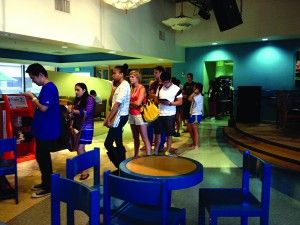
Mail Services implemented an up-to-the-minute mail alert in July for the new school year, replacing the pink slips put in mailboxes. Students on campus now receive package notifications through their Pepperdine email.
Though this method notifies students faster, the emails have created longer lines for people waiting to get packages. The average wait time to pick up a package in the Sandbar is about an hour and 15 minutes, according to student interviews. A larger incoming freshman class, students shopping online and the small number of mail service staffers, many of whom are part-time, have meant a noticeably longer line.
With limited time to pick up packages — Monday through Friday from 9 a.m. to 4:30 p.m. and Saturday from 9 a.m. to 2 p.m. — students are finding conflicting schedules between classes and obtaining their packages. The line is said to be especially long on Mondays.
“Yesterday, I waited an hour and 15 minutes,” freshman Madelyn Knowles said. “I never got it. I waited an hour starting at 10:45 a.m. and waited in line until noon. There were still people ahead of me, so I had to leave for class.”
Many are skeptical of the new system.
“The longest I waited was an hour and 15 minutes,” sophomore Spencer Ward said. “I think especially with the beginning of the year, people have more packages. I don’t know how the new system will work out, but it just seems very disorganized.”
Other students, like senior Morgan Soper, prefer the pink slips of the previous year.
“We got a pink slip, so it’s not like people checked their mail every day, not everyone waited in line at the same time,” Soper said. “With the new system, everyone gets an email notification when they get a package, so everyone checks their email at the same time and everyone comes at the same time, so the line is just way longer.”
However, as with every year, the length of the lines will decrease as the year progresses and demand for items and books diminishes.
According to John Carper, the director of Mail Services, the lines are due to die down by the end of September. He also explains that there is a limited amount of personnel because of the small working space in the mailroom and that the staff is sufficient for the rest of the year.
“There are peak times where we could use more staff, but I don’t have any more stations we can use,” said Carper. “The rest of the year, we’re doing okay.”
Caper said the two peak times of the year are the beginning of fall and spring. He also notes that the system was changed for the better and should improve in time, along with the number of packages eventually diminishing.
“We changed processes to speed it up,” said Carper. “Yes, we have a new tracking system, but it’s very similar to the old one. So we have to work on that.”
Carper also explains that the system is a process and each package must be manually scanned and accounted for: “The packages are first received at the Facilities Management & Planning Pad (FM&P), and then scanned, transferred and sorted out to be given to the recipients at the Student Mailbox Center.”
The packages are also sent to the mail office at two different times, first at 10:30 am. and later at 2:30 p.m., explaining why students receive emails at different times. They are handled by 12 employees staffed by mail services, three couriers, eight workers at the FM&P and two clerks. They handle not only student mail, but also mail for anyone at the university.
Because of IT issues from the vendor and scheduling of some time, the new system was installed last July instead of at the end of May. Carper explains that the new system is easier for mail services.
“The new system is more efficient, because one, we don’t have to put the pink slips on and go through that,” Carper said. “We’re still having to scan one time, so that’s still the same. But the new system is much more efficient as far as — it’s one slip, goes through, goes on, and sends, essentially. I would say the speed of the system is about the same at this point. Again, it’s a new system; we’re learning some of the little differences between the old system.”

